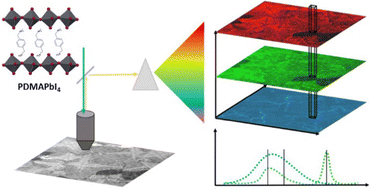Taking a closer look – how the microstructure of Dion–Jacobson perovskites governs their photophysics†
Abstract
Scarce information is available on the thin film morphology of Dion–Jacobson halide perovskites. However, the microstructure can have a profound impact on a material's photophysics and its potential for optoelectronic applications. The microscopic mechanisms at play in the prototypical 1,4-phenylenedimethanammonium lead iodide (PDMAPbI4) Dion–Jacobson compound are here elucidated through a combination of hyperspectral photoluminescence and Raman spectro-microscopy supported by x-ray diffraction. In concert, these techniques allow for a detailed analysis of local composition and microstructure. PDMAPbI4 thin films are shown to be phase-pure and to form micron-sized crystallites with a dominant out-of-plane stacking and strong in-plane rotational disorder. Sample topography, localised defects, and a strong impact of temperature-variation create a complex and heterogeneous picture of the luminescence that cannot be captured by a simplified bulk-semiconductor picture. Our study highlights the power of optical microscopy techniques used in combination, and underlines the danger of conceptual oversimplification when analysing the photophysics of perovskite thin films.

- This article is part of the themed collections: Journal of Materials Chemistry C Emerging Investigators and 2022 Journal of Materials Chemistry C Most Popular Articles


 Please wait while we load your content...
Please wait while we load your content...